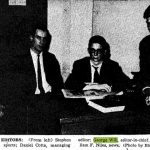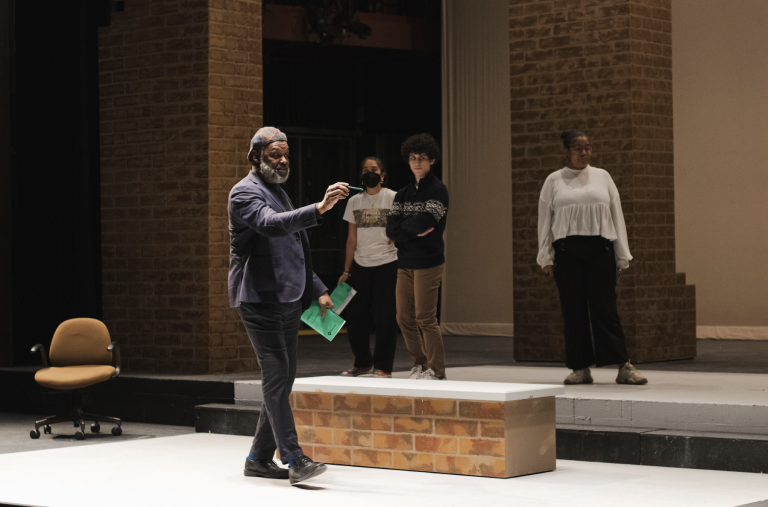TRIP SLAYMAKER ’18
A&E EDITOR
The element of danger can make any situation more interesting to watch on film. Danger is effective—it glues a viewer to a story like little else can. If that’s true, then Robert Zemeckis’s new film “The Walk” should have no problem at all in its effort to win the hearts of those who see it. But the movie, a chronicle of the 1974 tightrope walking “coup” of Philippe Petit, has some trouble as it works to achieve this feat.
Petit’s story begins in Paris, where the main character, a young French mime and stunt artist, became inspired to string a wire between the north and south towers of the World Trade Center in New York City and walk across it without any safety precautions.
Petit is played with a bulky and persistently Americanized French accent by none other than the talented and interminably dreamy Joseph Gordon-Levitt. Gordon-Levitt’s Petit is clearly the center of the movie—so much so that the friends he enlists to help him in his adventure, both French and American, are less endearing than sidekicks and yet have more screen time than simple extras. Philippe is our main man here: even our narrator. For this aspect of the role, Gordon-Levitt stands atop the torch of the statue of liberty, as if to remind us all that he enjoys high places. The character comes across as slightly mawkish and full of some kind of sugary magic. Petit explains and recounts the events of the story to us like a tour guide at a children’s museum.
As the film takes off, Petit, ever the optimist, begins to make his plans. The first act of the movie is a bit of a drag, lightened somewhat by the mentoring presence of Ben Kingsley as a classic grandfather type figure. When the crew arrives in New York, though, we are gifted with a bit more liveliness. The Twin Towers, which were still in the last days of their construction in 1974, are masterfully recreated with digital work. To enter the towers and attempt their grand feat, Petit and his friends must split up—one team to each tower—smuggle and distract their way up the skyscrapers. It makes for exciting heist style movie fun, but as the wire-walker and company spend a night in the top floors of the tower, hiding around corners to escape from a nameless security guard, there’s a sense that the filmmakers are simply stalling for time. It takes a moment before the savvy audience learns what all this is really leading up to, but it’s impossible to miss once you see it.
Just as this nighttime sequence begins to wear on a little too long—in fact, just when a perfectly reasonable viewer might be losing faith in this inspirational poster of a movie in general—something changes. It feels as if the wind has shifted somehow, high up on those towers, as the sun rises through a fog that is hanging over the city below. Though it may have been difficult to take him seriously so far, in the moment when Philippe Petit takes his first step out into the void, our stomachs drop collectively. The titular scene in “The Walk” is like a dose of real magic. It is gorgeous and scary, but there’s something about it that keeps it just out of step with the world of the real. Though helped hugely by the faithful recreation of the towers and the NYC landscape, much of the ingenuity of this scene comes from careful cinematography and, to give credit where it is due, a simple but effective performance from Gordon-Levitt. While it may be taxing on those who labor under a fear of falling from heights, it is not long before that ever important element of fear begins to subside. Instead, “The Walk” now projects a warm feeling of inspiration that keeps us from losing interest.
The actual sequence of the wire-walking lasts for a solid ten minutes at least. It is the crowning achievement of the entire film, certainly. But with regret, this is an achievement made far less impressive by the droopy and somewhat saccharine quality of the rest of the movie. One sequence, no matter how eye opening and beautiful it is, cannot retrieve the majority of “The Walk” from mediocrity; yet, it does help make this a worthwhile film. It is worthwhile, but less than stimulating for the most part.
For all of those who are interested in seeing “The Walk,” by all means see it—but then, go home, and watch another movie. This one is titled “Man on Wire” and was released in 2008. It is a documentary about the event at the center of “The Walk,” and is full of the wonder that is lacking in more earthbound sections of that film. It also contains a touch more darkness—an important aspect of a story that is less about a dream coming to life than it is about staring death in the face to fulfill that dream. See this, and you will feel some frustration with the fictionalized account, but more than that you’ll be amazed by a truly top notch film. “Man on Wire” directly inspired “The Walk,” which is to say that “The Walk” owes everything it has earned to the older documentary. While it is true that between the two there is a clear frontrunner—and that frontrunner is the one not headed by Mr. Joseph Gordon- Levitt—“The Walk” will thrill you regardless and remind you never to forget about the dangers of gravity- or the joys of forgetting them. “The Walk” runs at Cinestudio from Nov. 18 to 21.
Wednesday, January 15 2025
The Student Newspaper at Trinity College in Hartford, Connecticut




+ There are no comments
Add yours